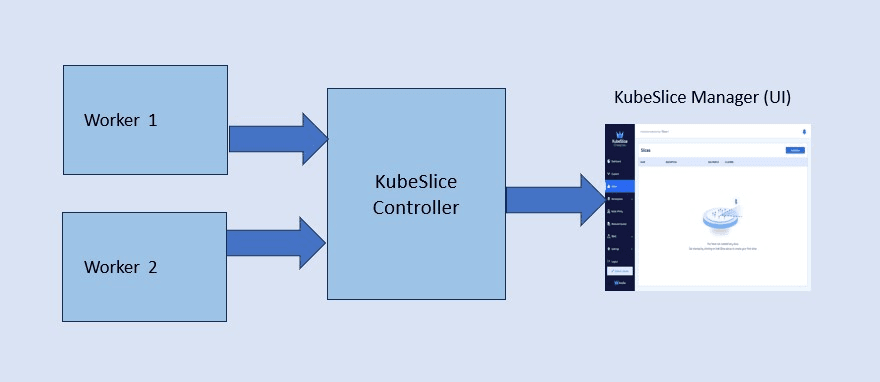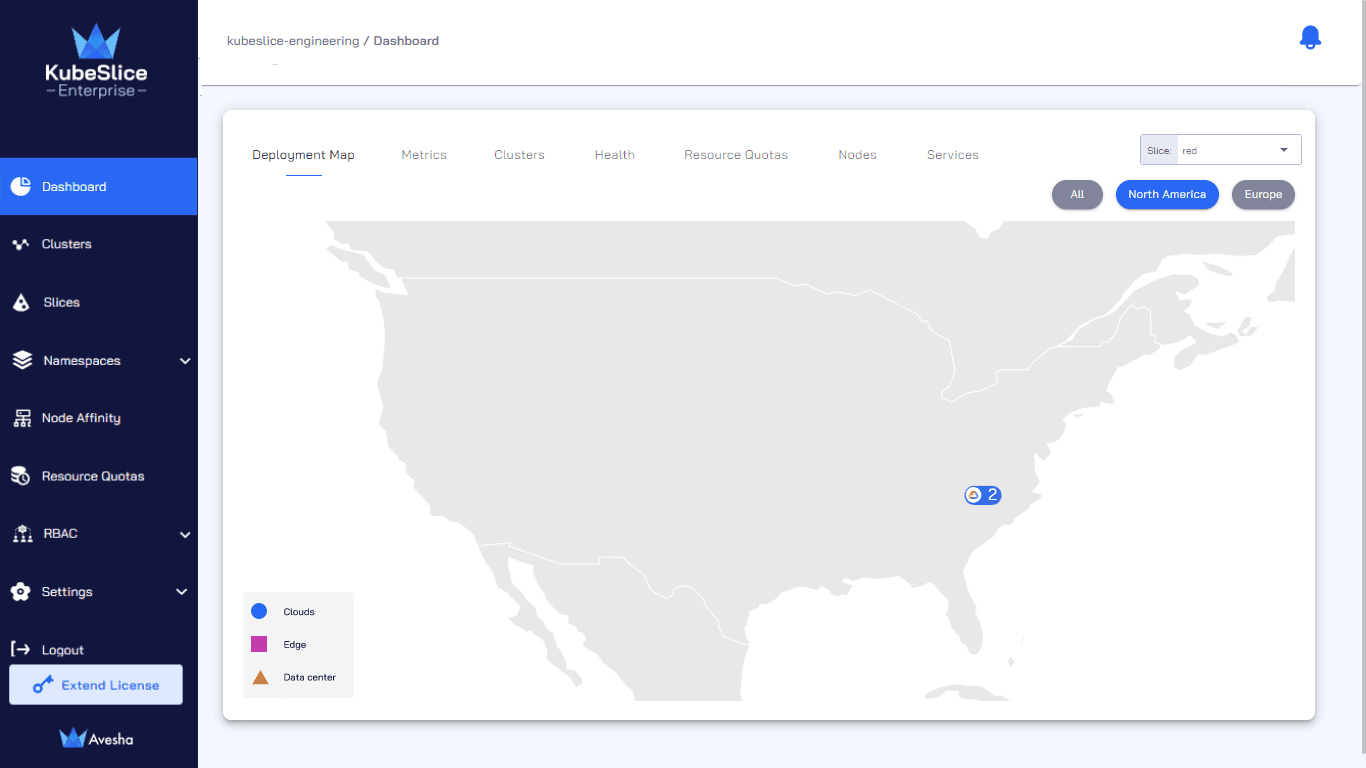Avesha Resources / Blogs
All you need to know about KubeSlice and its benefits
Uma Tammanagoudar
Technical Writer, Avesha

KubeSlice features a controller known as the control plane, which efficiently oversees a fleet of registered worker clusters. With the help of the user-friendly KubeSlice Manager(UI), you can easily manage multiple clusters, whether spread across various cloud providers, located within a single cloud across multiple regions, or in the same region.

What is Slice?
A slice serves as a conceptual unit, acting as a virtual cluster that extends across multiple clusters and establishes a logical boundary for applications. It enables seamless communication between pods and services within the slice. This concept goes beyond geographical constraints, allowing applications to be deployed across diverse clusters, clouds, edges, or Kubernetes (K8s) distributions.
Key Benefit of using KubeSlice
KubeSlice is a comprehensive framework that integrates network, application, Kubernetes, and deployment services, enabling faster application deployment in a multi-cluster, multi-tenant environment. It is a framework that combines network, application, Kubernetes, and deployment services to accelerate application deployment in a multi-cluster, multi-tenant environment.
The framework offers several key benefits, including:
1. Enhanced Scalability
With the ability to create slices across multiple clusters, you gain the flexibility to scale each slice independently and connect or disconnect clusters as needed. Each slice functions as a virtual cluster that can span multiple physical clusters, including those from different cloud providers such as GCP, Azure, or AWS. You can optimize resource allocation by effectively managing physical clusters, ensuring that critical tasks receive the resources required for optimal performance. This allows for more efficient resource utilization and the delivery of top-notch performance.
2. Enhanced Performance
KubeSlice addresses network and optimization challenges in edge, hybrid, and multi-cloud deployments, offering effective solutions for improved performance and reduced delays.
The Slice Router, a network service component within KubeSlice, delivers virtual Layer 3 IP routing functionality within a cluster for the Slice overlay network. It establishes a full mesh network connectivity between application pods and slice gateway pods within the cluster. Each slice router pod, provisioned per slice on a cluster, acts as a virtual Layer 3 device responsible for configuring routing and forwarding rules within the slice overlay network.
The Slice VPN Gateway, another essential component of the Slice network service, establishes a secure VPN tunnel between multiple clusters involved in the slice configuration. This ensures encrypted and protected communication between the controller and the connected worker clusters.
By employing these mechanisms, KubeSlice enhances network performance and reduces delays without the need for API gateways and firewalls. This results in faster speeds and lower latencies, leading to an improved user experience.
3. IdP Integration
Users can conveniently access project resources through the KubeSlice Manager by logging in using their company's identity provider (IdP). This streamlined process allows users to utilize their regular credentials, such as usernames and passwords, thereby eliminating the challenges faced by service account users. The integration of OIDC (OpenID Connect) facilitates this functionality with the IdP, ensuring seamless authentication and authorization. The IdP can be easily configured on well-known Kubernetes as a Service (KaaS) platforms like Google Kubernetes Engine (GKE), Amazon Elastic Kubernetes Service (EKS), and Azure Kubernetes Service (AKS). By leveraging this capability, users can securely log in and gain access to the specific resources they require for their projects, enhancing both convenience and security.
4. IP Address Management
By utilizing the RFC1918 CIDR address, it becomes possible to establish multiple slices within the same cluster or across cluster sets, thereby simplifying IP address management. The advantage of slice isolation is that the same CIDR can be used across multiple slices without any conflicts. When creating a slice, you have the flexibility to connect up to 32 clusters, providing a highly adaptable solution for managing IP addresses and network configurations. This capability streamlines the management process, making it straightforward to handle IP address assignments and network settings efficiently.
5. Traffic Management
Istio can leverage the capabilities of KubeSlice to facilitate communication across clusters. In particular, when a slice is configured to carry Istio traffic between clusters, it simplifies the deployment of Istio ingress and egress gateways. These gateways play a crucial role in publishing services across clusters, while KubeSlice gateways aid in transporting encrypted packets to their final destinations.
For external traffic that needs to reach services hosted within the Kubernetes cluster, Istio provides North-South gateways in an Istio implementation. KubeSlice, on the other hand, possesses the capability to automate the establishment of North-South gateways per slice. This automation feature streamlines the process of setting up gateways and enables efficient handling of external traffic directed towards services within the Kubernetes cluster when utilizing Istio and KubeSlice in conjunction
6. Simplified Management
KubeSlice significantly streamlines operations and reduces complexity within large clusters by simplifying the management and troubleshooting of each slice. The intuitive KubeSlice Manager UI empowers organizations to efficiently handle a fleet of clusters by providing user-friendly features. This user interface offers simple yet powerful tools and functionalities for managing and scaling applications.
With KubeSlice, organizations can prioritize security by leveraging essential features such as resource optimization, namespace isolation, RBAC management (Role-Based Access Control), and node affinity. These robust capabilities are available for each slice, enabling organizations to effectively manage and scale their applications while ensuring stringent security measures are in place.
By utilizing KubeSlice, organizations gain the ability to navigate and manage complex cluster environments, ultimately achieving higher operational efficiency. With streamlined operations, simplified management, and enhanced security, KubeSlice empowers organizations to optimize their cluster deployments and unlock the full potential of their applications.
7. Seameless Communication
KubeSlice implements the SIG-Multicluster ServiceExport/Import KEP-1645. With ServiceExport, you can configure a service within a KubeSlice to be exposed and discovered across all clusters associated with that slice. This feature enables seamless communication and accessibility of the service's endpoints throughout the clusters. The corresponding ServiceImport functionality ensures that the endpoints of the service are synchronized and made available across all clusters within the KubeSlice. This synchronization facilitates proper traffic routing and enables efficient service discovery through the KubeSlice DNS, enhancing overall connectivity and functionality.
8. KubeSlice Manager (UI)
The Dashboard page serves as the default startup page when logging into the KubeSlice Manager. It comprises several informative tabs, including the Deployment Map, Metrics, Clusters, Health, Resource Quotas, Nodes, and Services. The Deployment Map tab provides a visual representation of your clusters across different regions, whether they are situated in an edge environment, a cloud infrastructure, or a data center. For further details on the remaining tabs,please refer to the KubeSlice Manager Dashboard section.
The KubeSlice Manager Dashboard offers a user-friendly interface for monitoring cluster events and metrics. To stay informed about events, the KubeSlice Manager includes a dedicated Notifications page. This page can be accessed via a bell icon available on the dashboard and other relevant feature pages.
Events generated by the KubeSlice Controller reflect operations performed on the controller cluster, while events generated by the Slice Operator represent various operations executed on worker clusters. These events are specific to KubeSlice operations and provide valuable insights into the system's functioning.
Metric data, along with their respective timestamps, is collected and stored by Prometheus. These metrics are then displayed on the KubeSlice Manager dashboard, allowing users to easily monitor and analyze them

How secure is my Slice ?
The Slice serves as a comprehensive security framework that seamlessly spans multiple clusters and multiple cloud providers. By serving as a single security domain, it ensures a unified and consistent approach to security management, regardless of the number of clusters or cloud platforms involved.
The following factors help ensure the security of your slice:
1. TLS certificates
KubeSlice uses an OpenVPN TLS certificate configuration generator for slice gateways (for secure communication between the OpenVPN server and clients).
TLS certificates are used to authenticate the identity of the server and clients, ensuring that the communication is encrypted and secure. The use of TLS certificates in OpenVPN ensures secure and authenticated communication, protecting against eavesdropping and man-in-the-middle attacks.
2. Enhanced Network Security and Isolation
KubeSlice ensures that each slice is isolated from other slices within the cluster. This prevents unauthorized access and interference between different applications or services within separate slices. The network isolation provides a boundary that helps contain potential security breaches.
KubeSlice effectively addresses the issue of IP address conflicts that may arise when utilizing various cloud providers, data centers, or edge locations. It offers a solution by implementing network isolation and assigning distinct subnets based on the number of pods requiring communication across clusters.
To achieve this, KubeSlice establishes an overlay network specifically designed for inter-cluster communication. The overlay network is configured with a non-overlapping RFC1918 CIDR range, ensuring seamless and conflict-free connectivity.
KubeSlice goes a step further by providing comprehensive network isolation capabilities between slices. This robust isolation prevents unauthorized access and interference between different application components. It ensures that each slice operates within its designated boundaries, bolstering security and safeguarding the integrity of applications and their associated resources.
These features within KubeSlice enable organizations to overcome IP conflicts, establish secure communication channels across clusters, and maintain strict isolation between application components, ultimately enhancing network performance, security, and reliability.
3. RBAC Management
RBAC allows you to define and enforce specific access control policies for users and services within the slice. With RBAC, you can assign different roles and permissions to individuals or groups, ensuring that only authorized entities can access particular resources and functionalities. This helps protect sensitive information and prevents unauthorized actions within the slice.
4. Namespace Isolation
KubeSlice utilizes Kubernetes namespaces to separate and isolate different applications or services within a cluster. Each slice operates within its dedicated namespace, which provides an additional layer of isolation and security. By enforcing namespace isolation, KubeSlice limits the impact of any potential security breaches, containing them within the affected namespace and preventing lateral movement across slices.
5. Resource Optimization
KubeSlice incorporates resource management capabilities that empower you to effectively allocate resources within your slice. By optimizing resource utilization, KubeSlice mitigates the risk of resource exhaustion, which can be exploited by malicious actors. Ensuring proper resource allocation guarantees that your applications have the required resources to operate securely, minimizing the likelihood of performance degradation or disruptions. With KubeSlice's resource management features, you can enhance the security and stability of your applications by intelligently allocating resources as needed.
6. QoS Profile
The Netops pods play a critical role in enforcing the Quality of Service (QoS) Profile for each slice. They utilize Linux TC (Traffic Control) for traffic classification within the slice. Each slice within a cluster is associated with a specific QoS profile, which governs bandwidth control across the clusters. The QoS profile is applied to the external interface of the VPN gateway nodes. The NetOps pods are responsible for configuring and ensuring the enforcement of the QoS profile for each slice within a cluster.
It is essential to emphasize that maintaining the security of your slice necessitates proper configuration, adherence to security best practices, and regular updates and patches for the underlying components. Furthermore, it is crucial to follow the security guidelines provided by your cloud provider, Kubernetes, and any other technologies integrated with KubeSlice. Conducting regular security audits and implementing monitoring mechanisms are also vital to promptly identify and address any vulnerabilities or potential threats to your slice .
Conclusion
KubeSlice offers a comprehensive solution for effectively managing large-scale applications and infrastructure. By utilizing the KubeSlice Manager, organizations can efficiently handle their fleet of clusters, taking advantage of advanced features such as Resource Quota, Namespaces, Node Affinity, and RBAC.
The robust capabilities provided by KubeSlice enable organizations to streamline cluster management, allowing them to focus more on their core business activities. With the burden of managing a large number of clusters alleviated, organizations can devote their resources and attention to their primary objectives like never before. KubeSlice empowers organizations to optimize their cluster operations and concentrate on driving their main business forward with increased efficiency and effectiveness.
Copied